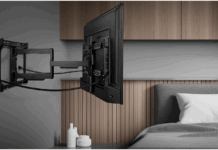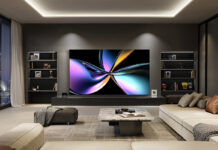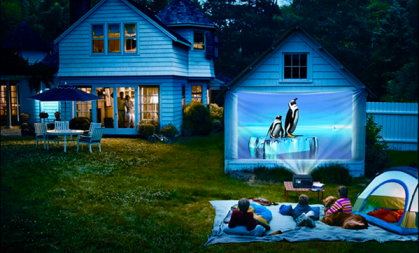 For a truly immersive entertainment experience, a projector gives you quality and a huge visual to enjoy on any wall you desire. Projection systems deliver a larger picture than most televisions you’d put in your house, and are small enough to hide away when they aren’t being used. Even with so much picture, they still provide all the clarity, vibrancy, and features that come with a flat screen. Projectors have come a long way, so throw away any old pre-conceived ideas you might have about them. If you are in the market for a new TV and have a big wall to fill, you can consider looking into a projector instead.
For a truly immersive entertainment experience, a projector gives you quality and a huge visual to enjoy on any wall you desire. Projection systems deliver a larger picture than most televisions you’d put in your house, and are small enough to hide away when they aren’t being used. Even with so much picture, they still provide all the clarity, vibrancy, and features that come with a flat screen. Projectors have come a long way, so throw away any old pre-conceived ideas you might have about them. If you are in the market for a new TV and have a big wall to fill, you can consider looking into a projector instead.
What types of projectors are out there?
There are essentially two types of machines: data and home theatre projectors. They are also known as business and home entertainment (or video) projectors. Both types will play a wide variety of content, but each does a better job on the purpose they were designed for. Data projectors are great for presentations, and home theatre is much better for videos.
How to get the most out of your brightness levels
 Brightness is measured in “lumens” and the number of lumens you need depends on the room that you plan to put it in. If you are setting up a home theatre room in your basement or other darker room, then 1,000 to 2,000 lumens will likely work fine. However, if you are putting it in a room that is well lit with lots of windows, then you should get a projector in the 2,000 to 3,000 lumen range. For example, the JVC 4K Laser UHD Front Projector shown here projects an image with a bright 3000 lumens. There isn’t an exact science with this but generally the more ambient light you have, the more lumens you will need.
Brightness is measured in “lumens” and the number of lumens you need depends on the room that you plan to put it in. If you are setting up a home theatre room in your basement or other darker room, then 1,000 to 2,000 lumens will likely work fine. However, if you are putting it in a room that is well lit with lots of windows, then you should get a projector in the 2,000 to 3,000 lumen range. For example, the JVC 4K Laser UHD Front Projector shown here projects an image with a bright 3000 lumens. There isn’t an exact science with this but generally the more ambient light you have, the more lumens you will need.
Different projection system technologies
There are 3 main technologies to consider: DLP, LCD, and LCOS. You can find great projectors using all of these technologies, it’s not necessarily that one is better than the others. However, there are tradeoffs between them. LCOS tend to have the best contrast and black levels but the other two tend to be brighter images. All have similar colour capabilities and DLP probably does the best with reducing motion blur. These are really generalizations, so the bottom line is don’t pick a projector based on these technologies as they can all perform well. Get one that projects an image you like.
Consider your space, or throw distance
The size of the room you are placing the projector in is important in order to determine the “throw” of the projector. A shorter throw projector has an ability to cast a larger image from a shorter distance from the screen. The average projector creates about an 80” image from about 12 to 15 feet away. So if you want a 100 or 120 inch image you will either need a bigger room so you can place the projector farther away or simply get a short-throw projector.
Make sure you have proper connectivity
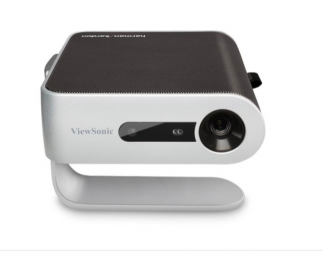 Just like you would consider connections for a new TV, make sure the projector has the connections you need. Most projectors will have at least a couple of HDMI ports, a VGA connector for a PC, and at least one component A/V input. Because wiring a projector in the back of your room can be a little more challenging, consider those projectors that have WiFi (usually through an optional wireless dongle that fits into a USB port). The ViewSonic Ultra-Portable WiFi Bluetooth Projector is a great option if you’re looking for something with a very easy, accessible set up.
Just like you would consider connections for a new TV, make sure the projector has the connections you need. Most projectors will have at least a couple of HDMI ports, a VGA connector for a PC, and at least one component A/V input. Because wiring a projector in the back of your room can be a little more challenging, consider those projectors that have WiFi (usually through an optional wireless dongle that fits into a USB port). The ViewSonic Ultra-Portable WiFi Bluetooth Projector is a great option if you’re looking for something with a very easy, accessible set up.
Enjoy clear resolution and vivid images
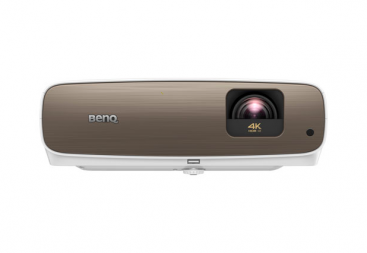 The picture clarity in a very large image from today’s projectors is awesome. Make sure you get at least a full 1080p HD projector, and if you have the extra cash 4K projectors will provide an even more immersive experience. The BenQ 4K UHD Home Theatre Projector is an excellent option if you’ve got the budget to get some vivid quality. Videos, gaming, or just looking at your personal photos on the giant screen can be very dramatic. Obviously, the more you spend, the more likely you will get a vibrant, high contrast, and clear picture. The good thing is that you don’t need to spend too much to get a great machine.
The picture clarity in a very large image from today’s projectors is awesome. Make sure you get at least a full 1080p HD projector, and if you have the extra cash 4K projectors will provide an even more immersive experience. The BenQ 4K UHD Home Theatre Projector is an excellent option if you’ve got the budget to get some vivid quality. Videos, gaming, or just looking at your personal photos on the giant screen can be very dramatic. Obviously, the more you spend, the more likely you will get a vibrant, high contrast, and clear picture. The good thing is that you don’t need to spend too much to get a great machine.
Set up some audio to go with it
Don’t expect much in terms of audio performance directly from a projector; so, don’t choose a projector based on its sound quality. I would always recommend augmenting a projection system with a sound bar or full surround system. The one aspect of audio that you should pay attention to is fan noise. Although projectors have become a lot quieter than in the past, some units can still be a little noisy. Depending on your tolerance for a little background noise while watching TV, you’ll want to consider the noise factor when selecting a projector.
Get the most out of your new projector
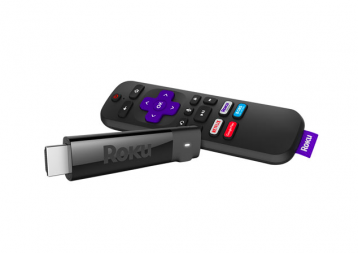 You won’t find Smart TV features in projection systems, but you can easily add them with a media streamer or by adding a gaming console or smart Blu-Ray player.
You won’t find Smart TV features in projection systems, but you can easily add them with a media streamer or by adding a gaming console or smart Blu-Ray player.
With all things considered, projectors can be a better value than flat screen TVs. They can deliver an extremely clear and vibrant picture in a 10 foot image. There is a great selection of Home Theatre projectors for you to browse and choose from. No matter what projection system you end up choosing, you can be guaranteed it’ll be a viewing experience you’ll love. For more information on how to pick out the perfect projector, check out this buying guide from the Best Buy Blog. Happy projecting!

